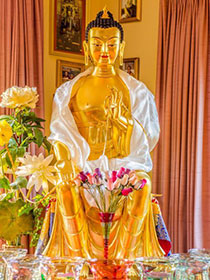- Home
- FPMT Homepage

Foundation for the Preservation of the Mahayana Tradition
The FPMT is an organization devoted to preserving and spreading Mahayana Buddhism worldwide by creating opportunities to listen, reflect, meditate, practice and actualize the unmistaken teachings of the Buddha and based on that experience spreading the Dharma to sentient beings. We provide integrated education through which people’s minds and hearts can be transformed into their highest potential for the benefit of others, inspired by an attitude of universal responsibility and service. We are committed to creating harmonious environments and helping all beings develop their full potential of infinite wisdom and compassion. Our organization is based on the Buddhist tradition of Lama Tsongkhapa of Tibet as taught to us by our founders Lama Thubten Yeshe and Lama Thubten Zopa Rinpoche.
- Willkommen
Die Stiftung zur Erhaltung der Mahayana Tradition (FPMT) ist eine Organisation, die sich weltweit für die Erhaltung und Verbreitung des Mahayana-Buddhismus einsetzt, indem sie Möglichkeiten schafft, den makellosen Lehren des Buddha zuzuhören, über sie zur reflektieren und zu meditieren und auf der Grundlage dieser Erfahrung das Dharma unter den Lebewesen zu verbreiten.
Wir bieten integrierte Schulungswege an, durch denen der Geist und das Herz der Menschen in ihr höchstes Potential verwandelt werden zum Wohl der anderen – inspiriert durch eine Haltung der universellen Verantwortung und dem Wunsch zu dienen. Wir haben uns verpflichtet, harmonische Umgebungen zu schaffen und allen Wesen zu helfen, ihr volles Potenzial unendlicher Weisheit und grenzenlosen Mitgefühls zu verwirklichen.
Unsere Organisation basiert auf der buddhistischen Tradition von Lama Tsongkhapa von Tibet, so wie sie uns von unseren Gründern Lama Thubten Yeshe und Lama Thubten Zopa Rinpoche gelehrt wird.
- Bienvenidos
La Fundación para la preservación de la tradición Mahayana (FPMT) es una organización que se dedica a preservar y difundir el budismo Mahayana en todo el mundo, creando oportunidades para escuchar, reflexionar, meditar, practicar y actualizar las enseñanzas inconfundibles de Buda y en base a esa experiencia difundir el Dharma a los seres.
Proporcionamos una educación integrada a través de la cual las mentes y los corazones de las personas se pueden transformar en su mayor potencial para el beneficio de los demás, inspirados por una actitud de responsabilidad y servicio universales. Estamos comprometidos a crear ambientes armoniosos y ayudar a todos los seres a desarrollar todo su potencial de infinita sabiduría y compasión.
Nuestra organización se basa en la tradición budista de Lama Tsongkhapa del Tíbet como nos lo enseñaron nuestros fundadores Lama Thubten Yeshe y Lama Zopa Rinpoche.
A continuación puede ver una lista de los centros y sus páginas web en su lengua preferida.
- Bienvenue
L’organisation de la FPMT a pour vocation la préservation et la diffusion du bouddhisme du mahayana dans le monde entier. Elle offre l’opportunité d’écouter, de réfléchir, de méditer, de pratiquer et de réaliser les enseignements excellents du Bouddha, pour ensuite transmettre le Dharma à tous les êtres. Nous proposons une formation intégrée grâce à laquelle le cœur et l’esprit de chacun peuvent accomplir leur potentiel le plus élevé pour le bien d’autrui, inspirés par le sens du service et une responsabilité universelle. Nous nous engageons à créer un environnement harmonieux et à aider tous les êtres à épanouir leur potentiel illimité de compassion et de sagesse. Notre organisation s’appuie sur la tradition guéloukpa de Lama Tsongkhapa du Tibet, telle qu’elle a été enseignée par nos fondateurs Lama Thoubtèn Yéshé et Lama Zopa Rinpoché.
Visitez le site de notre Editions Mahayana pour les traductions, conseils et nouvelles du Bureau international en français.
Voici une liste de centres et de leurs sites dans votre langue préférée
- Benvenuto
L’FPMT è un organizzazione il cui scopo è preservare e diffondere il Buddhismo Mahayana nel mondo, creando occasioni di ascolto, riflessione, meditazione e pratica dei perfetti insegnamenti del Buddha, al fine di attualizzare e diffondere il Dharma fra tutti gli esseri senzienti.
Offriamo un’educazione integrata, che può trasformare la mente e i cuori delle persone nel loro massimo potenziale, per il beneficio di tutti gli esseri, ispirati da un’attitudine di responsabilità universale e di servizio.
Il nostro obiettivo è quello di creare contesti armoniosi e aiutare tutti gli esseri a sviluppare in modo completo le proprie potenzialità di infinita saggezza e compassione.
La nostra organizzazione si basa sulla tradizione buddhista di Lama Tsongkhapa del Tibet, così come ci è stata insegnata dai nostri fondatori Lama Thubten Yeshe e Lama Zopa Rinpoche.
Di seguito potete trovare un elenco dei centri e dei loro siti nella lingua da voi prescelta.
- 欢迎 / 歡迎
简体中文
“护持大乘法脉基金会”( 英文简称:FPMT。全名:Foundation for the Preservation of the Mahayana Tradition) 是一个致力于护持和弘扬大乘佛法的国际佛教组织。我们提供听闻,思维,禅修,修行和实证佛陀无误教法的机会,以便让一切众生都能够享受佛法的指引和滋润。
我们全力创造和谐融洽的环境, 为人们提供解行并重的完整佛法教育,以便启发内在的环宇悲心及责任心,并开发内心所蕴藏的巨大潜能 — 无限的智慧与悲心 — 以便利益和服务一切有情。
FPMT的创办人是图腾耶喜喇嘛和喇嘛梭巴仁波切。我们所修习的是由两位上师所教导的,西藏喀巴大师的佛法传承。
繁體中文
護持大乘法脈基金會”( 英文簡稱:FPMT。全名:Found
ation for the Preservation of the Mahayana Tradition ) 是一個致力於護持和弘揚大乘佛法的國際佛教組織。我們提供聽聞, 思維,禪修,修行和實證佛陀無誤教法的機會,以便讓一切眾生都能 夠享受佛法的指引和滋潤。 我們全力創造和諧融洽的環境,
為人們提供解行並重的完整佛法教育,以便啟發內在的環宇悲心及責 任心,並開發內心所蘊藏的巨大潛能 — 無限的智慧與悲心 – – 以便利益和服務一切有情。 FPMT的創辦人是圖騰耶喜喇嘛和喇嘛梭巴仁波切。
我們所修習的是由兩位上師所教導的,西藏喀巴大師的佛法傳承。 察看道场信息:
- FPMT Homepage
- News/Media
-
- Study & Practice
-
-
- About FPMT Education Services
- Latest News
- Programs
- New to Buddhism?
- Buddhist Mind Science: Activating Your Potential
- Heart Advice for Death and Dying
- Discovering Buddhism
- Living in the Path
- Exploring Buddhism
- FPMT Basic Program
- FPMT Masters Program
- FPMT In-Depth Meditation Training
- Maitripa College
- Lotsawa Rinchen Zangpo Translator Program
- Universal Education for Compassion & Wisdom
- Online Learning Center
-
- Prayers & Practice Materials
- Overview of Prayers & Practices
- Full Catalogue of Prayers & Practice Materials
- Explore Popular Topics
- Benefiting Animals
- Chenrezig Resources
- Death & Dying Resources
- Lama Chopa (Guru Puja)
- Lama Zopa Rinpoche: Compendium of Precious Instructions
- Lama Zopa Rinpoche: Life Practice Advice
- Lama Zopa Rinpoche Practice Series
- Lamrim Resources
- Mantras
- Prayer Book Updates
- Purification Practices
- Sutras
- Thought Transformation (Lojong)
- Audio Materials
- Dharma Dates - Tibetan Calendar
- Translation Services
- Publishing Services
- Ways to Offer Support
- Prayers & Practice Materials
-
- Teachings and Advice
- Find Teachings and Advice
- Lama Zopa Rinpoche Advice Page
- Lama Zopa Rinpoche: Compendium of Precious Instructions
- Lama Zopa Rinpoche Video Teachings
- ༧སྐྱབས་རྗེ་བཟོད་པ་རིན་པོ་ཆེ་མཆོག་ནས་སྩལ་བའི་བཀའ་སློབ་བརྙན་འཕྲིན།
- Podcasts
- Lama Yeshe Wisdom Archive
- Buddhism FAQ
- Dharma for Young People
- Resources on Holy Objects
- Teachings and Advice
-
-
*If a menu item has a submenu clicking once will expand the menu clicking twice will open the page.
-
-
- Centers
-
- Teachers
-
- Projects
-
-
-
-
*If a menu item has a submenu clicking once will expand the menu clicking twice will open the page.
-
-
- FPMT
-
-
-
-
-
Use problems as ornaments, seeing them as extremely precious, because they make you achieve enlightenment quickly, by getting you to achieve bodhicitta. Experience these problems on behalf of all sentient beings, giving all happiness to sentient beings. This is the ornament.
Lama Zopa Rinpoche
-
-
-
- Shop
-
-
-
The Foundation Store is FPMT’s online shop and features a vast selection of Buddhist study and practice materials written or recommended by our lineage gurus. These items include homestudy programs, prayers and practices in PDF or eBook format, materials for children, and other resources to support practitioners.
Items displayed in the shop are made available for Dharma practice and educational purposes, and never for the purpose of profiting from their sale. Please read FPMT Foundation Store Policy Regarding Dharma Items for more information.
-
-
FPMT News Around the World
20
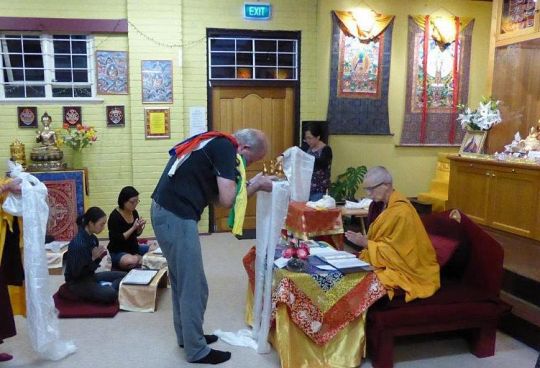
Owen Cole offering the mandala to Ven. Tenzin Tsapel, Hayagriva Buddhist Centre, Perth, Western Australia, January 2019. Photo by Hayagriva Buddhist Centre.
Hayagriva Buddhist Centre, an FPMT center in Perth, Western Australia, offered a six-week Buddhist Summer School program during the Australian summer, from January 8-February 10, 2019, consisting of teachings, meditations, and workshops led by Australian visiting FPMT registered teachers Ven. Thubten Dondrup and Ven. Tenzin Tsapel. This was Ven. Tsapel’s first visit to the center. Center member Owen Cole shares the story.
Geshe Ngawang Sonam, Hayagriva Buddhist Centre’s resident geshe, was on holiday, many people had leave for the summer holiday with time on their hands, so it was an ideal time for a Buddhist Summer School.
Our center’s much loved former resident teacher, Ven. Dondrub, was in Perth for almost two weeks in January teaching from January 8-20, 2019, and Ven. Tsapel, who had never previously visited our center, came after him for a similar period, teaching from January 24-February 10.
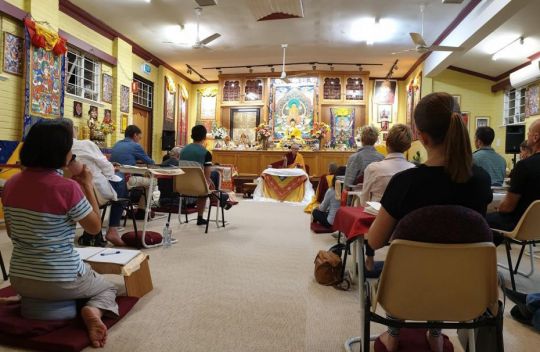
Ven. Tenzin Tsapel teaching at Hayagriva Buddhist Centre, Perth, Western Australia, January 2019. Photo by Hayagriva Buddhist Centre.
Ven. Tenzin Tsapel has been ordained for 34 years, studied the Dharma at FPMT center Chenrezig Institute for 15 years, and taught at FPMT centers in a number of countries.
It didn’t matter that most students didn’t know her as Ven. Tsapel’s warmth and down-to-earth manner captured the hearts of many students. Her program had something for everyone, from an explanation of Buddhist prayers and prostrations to teachings on the three poisonous minds and a Vajra Yogini self-initiation.
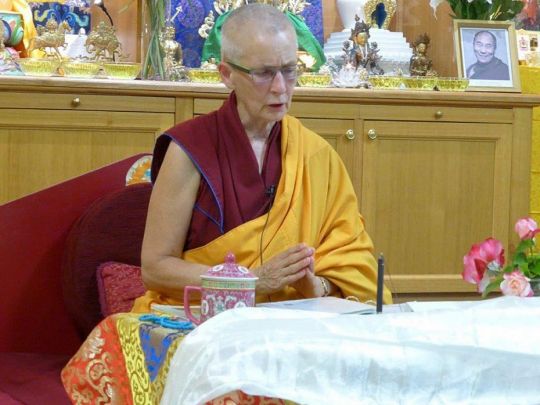
Ven. Tenzin Tsapel teaching at Hayagriva Buddhist Centre, Perth, Western Australia, January 2019. Photo by Hayagriva Buddhist Centre.
Long-time student and former spiritual program coordinator Susan di Bona found great benefit from having teachings from a woman’s perspective. “We are of similar age so there is already a feeling of sisterhood. Ven. Tsapel’s stories about the Dharma used life experience to illustrate points; this came more easily from a female teacher,” Susan said.
One of our youngest students Zendra Giraudo said she found Ven. Tsapel accessible, and that she resonated with Ven. Tsapel more than other people. “Ven. Tsapel has a grounding presence which makes it easier to understand the teachings,” Zendra said.
Another relatively new student, Penni Sutton, said she benefited from the way Ven. Tsapel linked the three poisonous minds of anger, greed, and ignorance, and that she really connected with Ven. Tsapel. “What I like about FPMT is that there are so many teachers and you get a little bit more with every teaching you receive,” Penni said.

Ven. Tenzin Tsapel with Swee Lin Tan, Poh Choo Tan, Sau Chee Chiew, Cheryl Choong, Stella Low, and AK Ch’ng celebrating Australia National Day, Perth, Western Australia, January 2019. Photo by Hayagriva Buddhist Centre.
Long time student Ros Charron said, “I was totally captivated. It was as if someone had switched on a light in my mind not only through slightly differently wording phrases but by the explanations, which were succinct and clear.”
A fundraising dinner and raffle for Machig Labdron Nunnery, which Ven. Tsapel is establishing, raised more than US$900. The nuns community will share a site in Bendigo with the Great Stupa for Universal Compassion, Thubten Shedrup Ling Monastery, and Atisha Centre, and so will be part of a Buddhist oasis in Australia.
We thank Ven. Tsapel for the knowledge and time she gave us collectively and as individuals and would love to have her back.
For more information about Hayagriva Buddhist Centre visit their website:
http://hayagriva.org.au
FPMT.org and Mandala Publications brings you news of Lama Zopa Rinpoche and of activities, teachings, and events from over 160 FPMT centers, projects, and services around the globe. If you like what you read, consider becoming a Friend of FPMT, which supports our work.
16
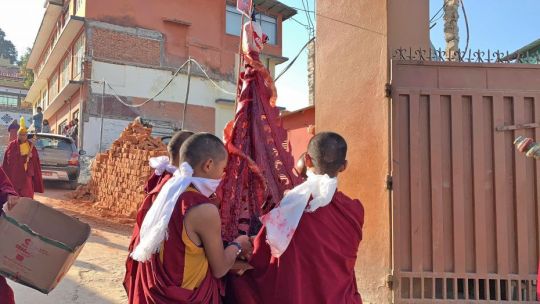
Kopan monks departing Kopan Monastery with a torma symbolizing Kalarupa, Kathmandu, Nepal, February 2019. Photo by Geshe Tashi Sherab.
The community at Kopan Monastery, the FPMT monastery in Kathmandu, Nepal, shares about the annual Losar (Tibetan New Year) rituals that took place at Kopan in 2019.
The Tibetan Losar tradition contains elements and values that we all share as human beings, and, similar to Western cultures, the New Year here means a fresh beginning. Losar rituals have many Buddhist elements, but Losar is primarily a secular event with its own flavor.
At all the major monasteries, special ceremonies called Gyutor are performed on the last day of the year. The purpose of these ceremonies is to move into the new year with a clean slate after having purified the negativities of the past year.
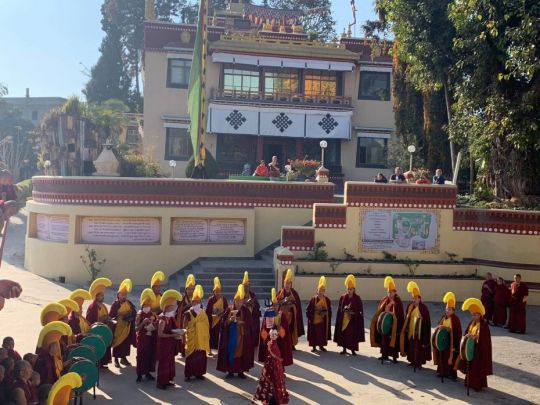
Kopan monks making offerings to a torma symbolizing Kalarupa, Kopan Monastery, Kathmandu, Nepal, February 2019. Photo by Geshe Tashi Sherab.
At Kopan Monastery, the purification ceremonies start with an extensive puja by the tantric monks in which vast amounts of offerings are made to the protectors. A special torma symbolizing Kalarupa is consecrated, which will later be offered to the fire. In the puja, extensive offerings are made, and all the protectors of the teachings of the Buddha are beseeched to fulfill the pledges they made in the past.
The rituals continue with the assembly of the tantric monks in the Kopan Monastery courtyard, with the torma placed in the middle. The ritual master first performs an extensive tea offering to the protectors in which they are requested to remove all hindrances and obstacles. The tea offering is repeated four times, with the first one dedicated to the Lama, the second one to the Deity, the third one to all enlightened protectors, and the fourth to the worldly protectors and the landlords.
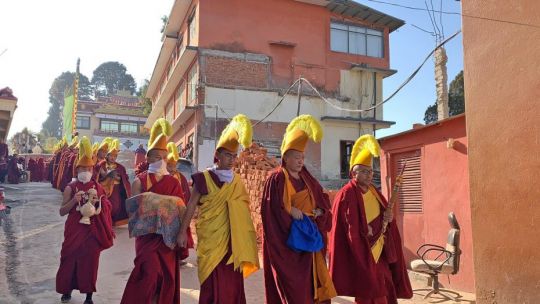
Geshe Lhakpa, Geshe Thubten Jinpa, and a procession of Kopan monks departing Kopan Monastery, Kathmandu, Nepal, February 2019. Photo by Geshe Tashi Sherab.
Following this, the torma is carried in a procession with music and chanting of prayers to a nearby field where a straw hut has been erected. The torma is then thrown into the burning straw hut, symbolically destroying all negativities and causes of negativities, the grasping and self-cherishing mind. Prayers are made for the removal of all obstacles to the teachings of Lama Tsongkhapa, and for the teachings to continue for a long time.
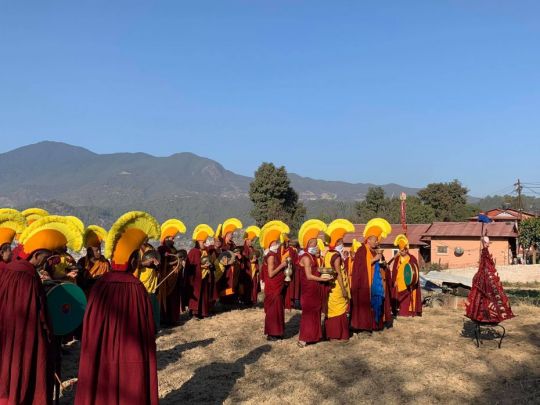
Extensive dedications made to the torma symbolizing Kalarupa, Kathmandu, Nepal, February 2019. Photo by Geshe Tashi Sherab.
Extensive dedications are made throughout the rituals. All FPMT centers, projects, services, and students are always included in the prayers to remove all obstacles and to have the right conditions to fulfill all the wishes of all the lamas, and in particular the wishes of His Holiness Dalai Lama and Lama Zopa Rinpoche.
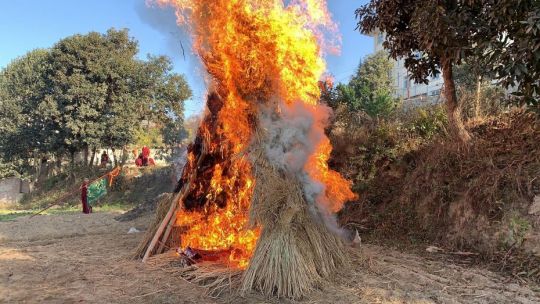
Fire in a bamboo and straw hut consuming a torma symbolizing Kalarupa, Kathmandu, Nepal, February 2019. Photo by Geshe Tashi Sherab.
Watch Kopan Monastery’s short video of the puja:
https://youtu.be/DJFShkjqHaw
The next day is Losar, the New Year’s day, which is welcomed in the monasteries with a Palden Lhamo puja in the early morning, followed by a celebration of Guru Puja with extensive tsog offering at 8 a.m. This being the main puja of the New Year, it goes on until midday.
Losar is mostly celebrated over three days.
The first day is dedicated to the lamas. This is when lay people go to the monasteries to make offerings and visit their teachers to receive a blessing string. The monasteries celebrate this day as the first day of the Fifteen Days of Miracles. At Kopan Monastery this is also the anniversary of Lama Yeshe’s passing.
The second day is dedicated to the king or leader of the country. The third day is then dedicated to the family.
For more information about Kopan Monastery and Khachoe Ghakyil Nunnery:
http://kopanmonastery.com/
http://www.kopannunnery.org/
FPMT.org and Mandala Publications brings you news of Lama Zopa Rinpoche and of activities, teachings, and events from over 160 FPMT centers, projects, and services around the globe. If you like what you read, consider becoming a Friend of FPMT, which supports our work.
- Tagged: kalarupa, kopan monastery, losar
6
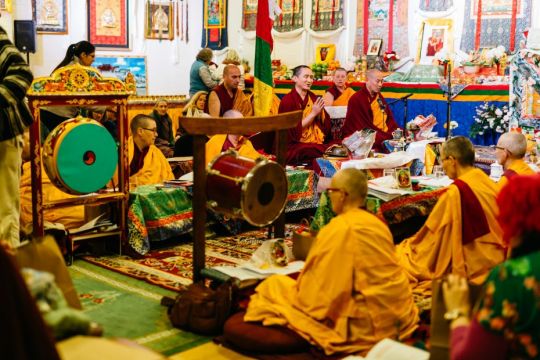
Guru bumstog, Tasmania, Australia, November 2018. Photo by Markus Ravik.
FPMT Sangha and students gathered together at the Kickstart Community Arts Centre in New Town, Tasmania, in November 2018 to make 100,000 tsog offerings to Guru Rinpoche, also known as Padmasambhava. This was the second year in a row that the FPMT Australia National Office organized and FPMT center Chag Tong Chen Tong Centre, Tasmania, co-hosted a Guru bumtsog. They were assisted in the months leading up to and during the event by students and executive committee members from Logsang Dragpa Centre, the FPMT center in Selangor, Malaysia. This created a warm, FPMT global family feeling at the four-day event. FPMT center Vajrayana Institute student Shannon Murphy shares the story.
An auspicious annual event took place in a suburb of Hobart, Tasmania, in November 2018. Geshe Thubten Rabten, the FPMT resident geshe from Atisha Centre and Thubten Shedrup Ling Monastery; Geshe Phuntsok Tsultrim, the FPMT resident geshe from Chenrezig Institute; and Geshe Tenzin Zopa, an FPMT touring geshe were among eighteen ordained Sangha and more than one hundred men, women, and children from FPMT centers all over Australia and beyond who came together for a Guru bumtsog.
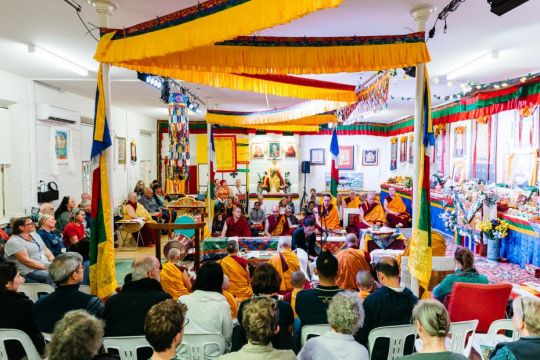
Guru bumtsog, Tasmania, Australia, November 2018. Photo by Markus Ravik.
The event honored Guru Rinpoche an 8th-century Buddhist master from India who played an essential role in the flourishing of Buddhism in Tibet. He represents an embodiment of the Dharma lineage, so that the ritual of making offerings to Guru Rinpoche was an offering to all our precious teachers, notably His Holiness the Dalai Lama and Lama Zopa Rinpoche, and an offering to the Buddha potential within every being.
We kept in mind all those who suffer in the cycles of life, death, and the bardo, in all realms of existence. With this expansive view, the aspiration was to make 100,000 tsog offerings and 100,000 mantra recitations during our four days together!
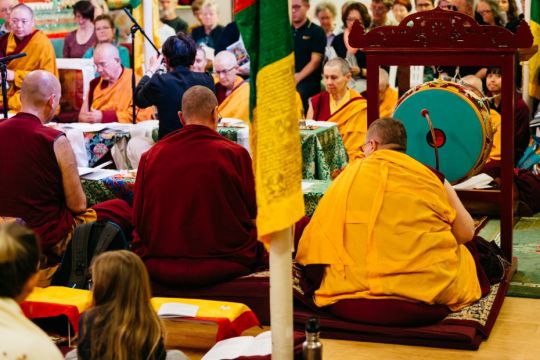
Geshe Phuntsok Tsultrim, Ven. Thubten Dondrub, Ven. Tenzin Tsapel, and Ven. Tenzin Chodron at the Guru bumtsog, Tasmania, Australia, November 2018. Photo by Markus Ravik.
Geshe Tenzin Zopa led the prayers and mantras, inspiring us with heart-felt motivations and rotating chant tunes with support from Geshe Thubten Rabten. Geshe Tenzin Zopa and Ven. Lozang Sherab—who sometimes assists at FPMT center Langri Tangpa Centre—offered music on the big brass cymbals. Ven. Thubten Chokyi and Ven. Lozang Thubten from FPMT center Chenrezig Institute offered music on the drums.
It created a powerful practice that, once we got our tongues around the Tibetan, could really carry the mind into an expansive offering. The practice sessions were solid blocks of mantra recitation that lasted for a couple of hours each, five sessions a day.
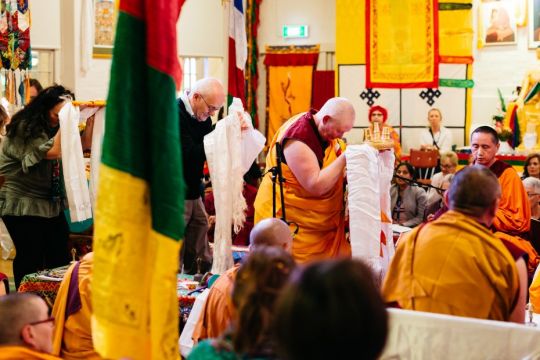
Chag Tong Chen Tong Centre director Ven. Lindy Mailhot, FPMT Australia national coordinator Peter Stickels, and education coordinator Stephanie Brennan making the offerings at the Guru bumtsog, Tasmania, Australia, November 2018. Photo by Markus Ravik.
To refresh us between sessions, we were generously catered for by the Chag Tong Chen Tong Centre community, with a variety of hot drinks, delicious pastries, and freshly prepared breakfasts and lunches.
Participants caught up with old friends and met new ones. Some took time to do personal meditation or to visit the exhibition of holy artworks curated in the art center by artist Martin Watson Walker.
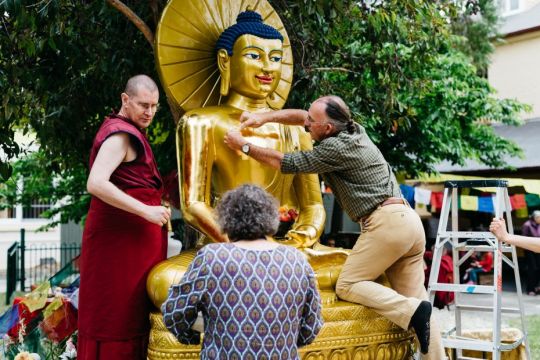
Ven. Tenzin Sherab, Mary Richards, and Martin Walker-Watson making offerings to the Buddha at the Guru bumtsog, Tasmania, Australia, November 2018. Photo by Markus Ravik.
A large Buddha Shakyamuni, one of the preliminary sculptures made for the Jade Buddha for Universal Peace, was positioned in the heart of the garden for guests to circumambulate and make light, incense, water bowl, and Sur offerings to, while stupas, thangkas, relics, and extensive offerings were arranged in the hall.
Martin oversaw the gilding of the beautiful Buddha so that participants could make offerings of gold leaf. Placed around the centerpiece were hundreds of water bowls, which gradually filled with multicolored blossoms. Incense billowed and candles flickered. When the rain came down the monks and nuns led the congregation under umbrellas to offer Sur prayers before the dusk settled.
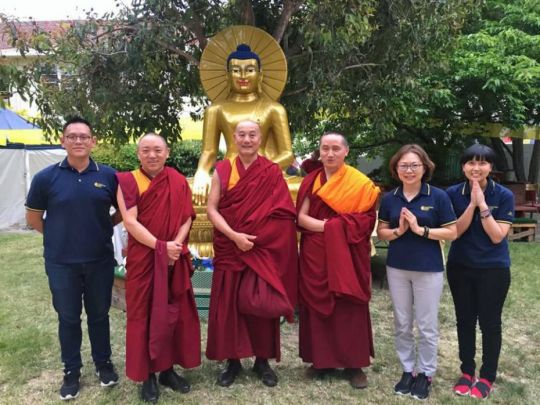
Gavyn Teh, Losang Dragpa Centre (LDC) program support and setup, Geshe Phuntsok Tsultrim, Geshe Thubten Rabten, Geshe Tenzin Zopa, Candy Tan, LDC spiritual program coordinator, and Lua Chiew Fei, LDC assistant spiritual program coordinator, Tasmania, Australia, November 2018. Photo courtesy of Candy Tan.
One participant commented that for years he had kept getting blocked in his study of Dharma. He found incorporating prayer and mantra into his practice has been instrumental to opening his mind.
When we put all the busy demands of life aside and focus on our intention to create the causes for the elimination of all suffering, that all beings receive all the conducive conditions that will lead to an enlightened state, what an incredible practice of compassion it becomes! All the more inspiring to do it in a group setting where there where more than one hundred people were sharing a space and an intention to put good energy out into the world.
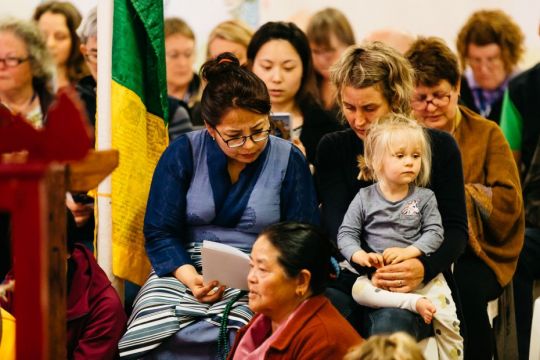
Students participating in the Guru bumtsog, Tasmania, Australia, November 2018. Photo by Markus Ravik.
For more information about FPMT Australia, visit their website:
http://fpmta.org.au/
For more information about Chag Tong Chen Tong, visit their website:
https://www.chagtong.org/
FPMT.org and Mandala Publications brings you news of Lama Zopa Rinpoche and of activities, teachings, and events from over 160 FPMT centers, projects, and services around the globe. If you like what you read, consider becoming a Friend of FPMT, which supports our work.
- Tagged: australia, guru bumtsog, guru rinpoche, losang dragpa centre
27
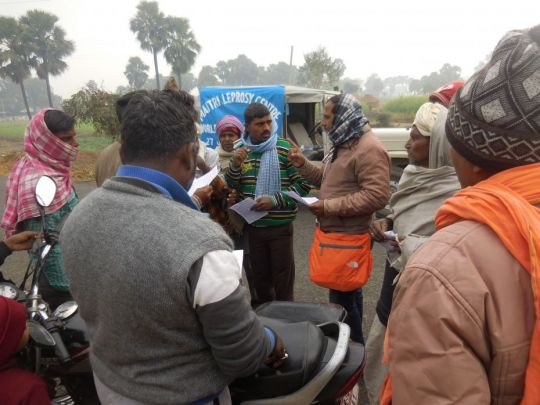
MAITRI field coordinator Binod Patra and teacher Ganesh Sharma raising awareness about leprosy in a village, Gaya District, Bihar, India, February 2019. Photo by MAITRI.
FPMT project MAITRI Charitable Trust in Bodhgaya, Gaya District, Bihar, India, celebrated World Leprosy Day on January 27, 2019. The day’s activities included a visit to MAITRI’s leprosy awareness stall by Lama Zopa Rinpoche. MAITRI’s director, Adriana Ferranti, shares the story.
World Leprosy Day is not only a day of reflection on the victims of this devastating disease. It is first and foremost a day of solidarity with our brothers and sisters who are afflicted by it.
Leprosy is still widespread in India and particularly in Bihar. It can affect anybody: rich and poor; high and low caste; male and female; child and adult; educated and uneducated.
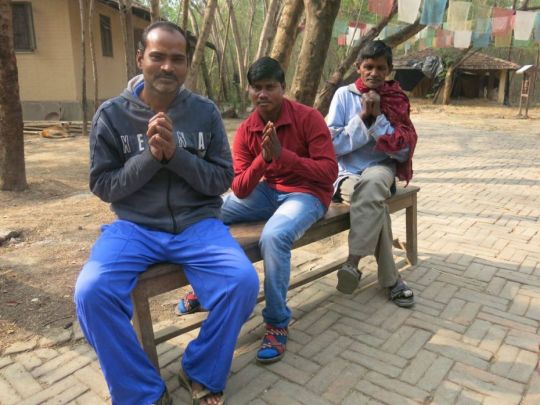
MAITRI leprosy patients Shankar Mahto, Kamlesh Manjhi who was discharged in February 2019 after more than two months of treatment, and Ramswaroop Paswan, MAITRI, Bodhgaya, Gaya District, Bihar, India, February 2019. Photo by MAITRI.
Leprosy is a communicable disease, but one of the least contagious ones. It is caused by the germ Mycobacterium leprae; it is neither hereditary nor a curse. If left untreated, the intense inflammation that causes severe swelling of the person’s features can lead to permanent scars and deformities. However, if treated with regular care and medication, the recovery can be full.
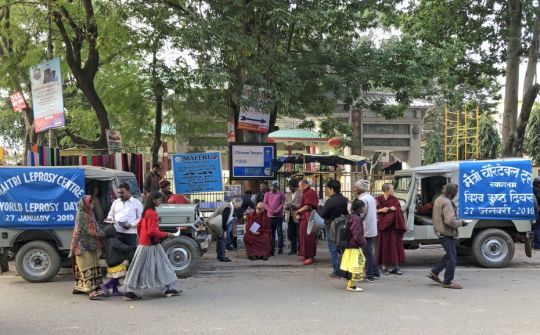
Lama Zopa Rinpoche visiting MAITRI’s leprosy awareness stall near the Mahabodhi Temple, Bodhgaya, Gaya District, Bihar, India, February 2019. Photo by Ven. Roger Kunsang.
MAITRI’s celebration of World Leprosy Day traditionally consists of an awareness campaign about the disease and its treatment in most provinces of Gaya District. Two teams of paramedical workers travel on two jeeps equipped with loudspeakers, heading to different destinations in the district, visiting villages in forgotten corners of the hinterland. The workers interact with the population, distribute leaflets, and possibly detect new cases.
By 3 p.m., both jeeps converge at our stall in Bodhgaya, where a worker has kept the MAITRI stall open since early morning. All field staff—joined by the teachers and myself—continue addressing the public and distributing leaflets until 5 p.m.
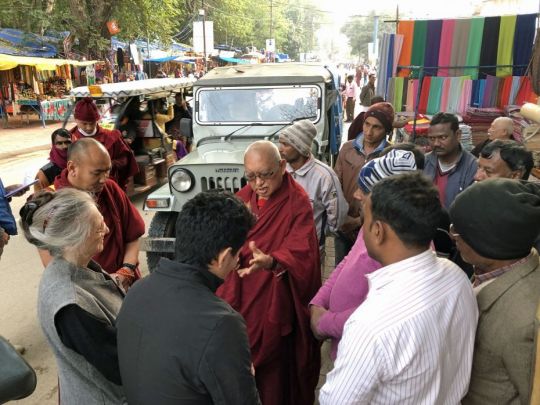
Lama Zopa Rinpoche advising Adriana Ferranti and MAITRI staff, Bodhgaya, Gaya District, Bihar, India, February 2019. Photo by Ven. Roger Kunsang.
On the teams’ return to the campus, the celebration ends with the distribution of samosas and sweets to MAITRI inpatients, the living representatives for whom MAITRI was created almost thirty years ago.
In 2018 we assessed 586 high risk cases; instructed 792 disabled cases for self-care; and trained 576 deformed patients, 2,983 community members and 417 government staff members. MAITRI held thirty-four camps to distribute sandals and dressing kits. We assisted the government with bi-monthly leprosy sections at the government-run public health clinics and carried out education programs across the region. At MAITRI Hospital fifty-nine ulcer cases and two reaction cases have been admitted.
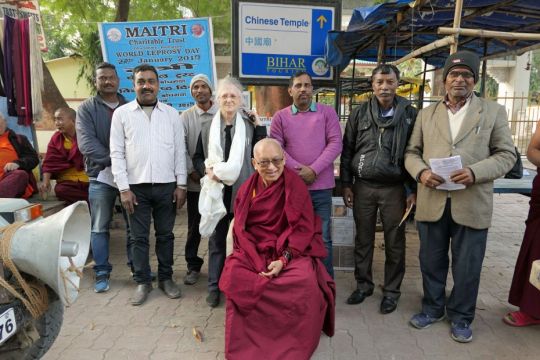
Lama Zopa with Adriana Ferranti and MAITRI staff, Bodhgaya, Gaya District, Bihar, India, February 2019. Photo by Ven. Roger Kunsang.
For more information about MAITRI Charitable Trust, visit their website:
http://www.maitri-bodhgaya.org/home/
For the seventh year, due to the kindness of a benefactor, the FPMT Social Services Fund has been offering substantial grants to MAITRI in support of their incredible and compassionate work and service.
FPMT.org and Mandala Publications brings you news of Lama Zopa Rinpoche and of activities, teachings, and events from over 160 FPMT centers, projects, and services around the globe. If you like what you read, consider becoming a Friend of FPMT, which supports our work.
20
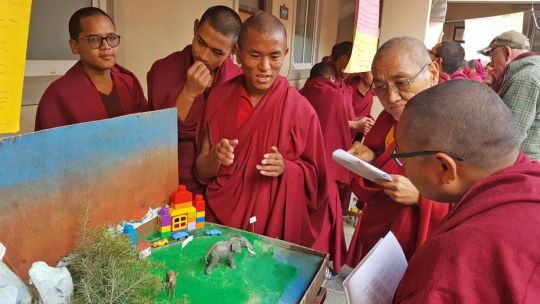
Kopan Monastery School student Ven. Lobsang Yonten explaining his team’s project to Khen Rinpoche Geshe Thubten Chonyi and Geshe Thubten Jinpa at the school’s Science Fair, Kopan Monastery, Kathmandu, Nepal, January 2019. Photo by Geshe Tashi Sherab.
On Sunday, January 13, 2019, Kopan Monastery School at FPMT’s Kopan Monastery in Kathmandu, Nepal, held their second-ever Science Fair. They invited the local community to come to the monastery to talk with the students and learn about their group projects. Kopan Monastery School Headmaster Geshe Tashi Sherab shares the story.
Although we have had a science class at Kopan Monastery School since the very beginning of the school’s founding in 2009, last year was the first year we held a Science Fair.
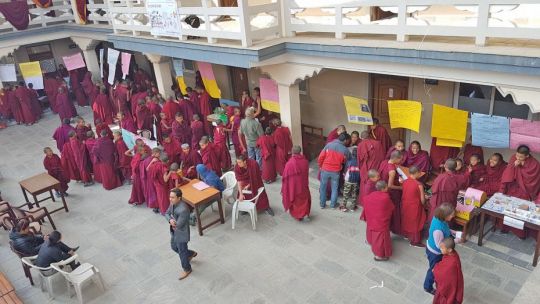
Kopan Monastery School Science Fair, Kopan Monastery, Kathmandu, Nepal, January 2019. Photo by Photo by Geshe Tashi Sherab.
I think it’s very important not only to give students theoretical explanations, but to also engage the students in projects which depend on teamwork.

Kopan Monastery School student Ven. Lhundub Pelkar explaining his team’s project at the school’s Science Fair, Kopan Monastery, Kathmandu, Nepal, January 2019. Photo by Geshe Tashi Sherab.
This Science Fair was all the result of their teamwork. They had been working on it for more than a week. I am amazed to see their passion and efforts. All of the students—including our youngest students who are seven years old—are involved in these events.
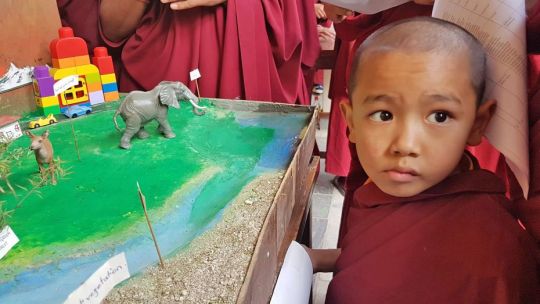
Thubten Rigsel Rinpoche exploring the Kopan Monastery School Science Fair, Kopan Monastery, Kathmandu, Nepal, January 2019. Photo by Geshe Tashi Sherab.
The reasons we teach science to our Buddhist monks is as follows: both science and Buddhism are looking for the truth—whatever it may be. We use philosophical methods and scientists use experiments to discover the truth. So, if we can learn the methodology of science, it is going help us a lot. That’s why we feel it is very important to introduce science to our students.
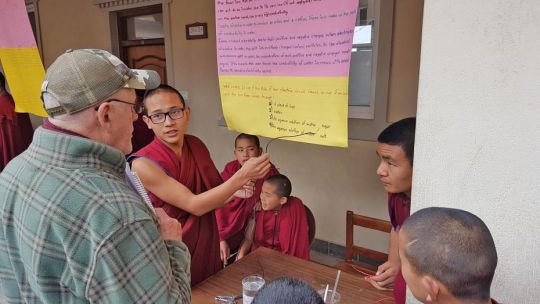
Kopan Monastery School students Ven. Lobsang Choezin and Ven. Lobsang Jampa explaining their team’s project at the school’s Science Fair, Kopan Monastery, Kathmandu, Nepal, January 2019. Photo by Geshe Tashi Sherab.
For more information about Kopan Monastery and Khachoe Ghakyil Nunnery:
http://kopanmonastery.com/
http://www.kopannunnery.org/
FPMT.org and Mandala Publications brings you news of Lama Zopa Rinpoche and of activities, teachings, and events from over 160 FPMT centers, projects, and services around the globe. If you like what you read, consider becoming a Friend of FPMT, which supports our work.
- Tagged: geshe tashi sherab, geshe thubten jinpa, khen rinpoche geshe chonyi, kopan monastery, kopan monastery school, nepal, science, thubten rigsel rinpoche, ven. lhundub pelkar, ven. lobsang choezin, ven. lobsang jampa, ven. lobsang yonten
13
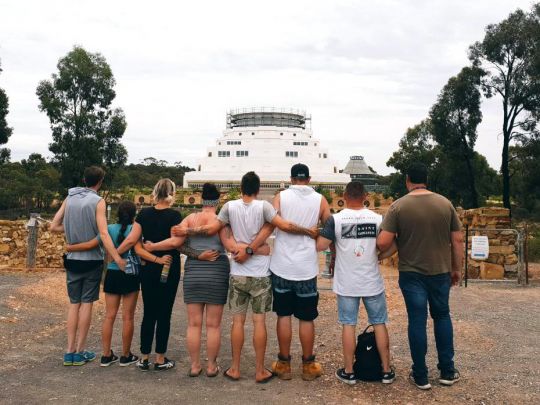
Alcohol and Other Drugs Program participants gazing with arms locked at the Great Stupa of Universal Compassion, Bendigo, Australia, January 2019. Photo by Alyce Crosbie.
The Great Stupa of Universal Compassion, a FPMT project near Bendigo in Victoria, Australia, has been running an Alcohol and Other Drugs Program for the past several months. Community service is one of the five FPMT Pillars of Service. Participants in the Salvation Army Bridge Program—a live-in six-week recovery program for men and women with an alcohol and/or drug addiction—visit the Great Stupa of Universal Compassion (the Great Stupa) once every two weeks for art therapy, mindfulness, and meditation activities. Participants occasionally have the opportunity to ask questions of a Buddhist nun from the FPMT community. Rhiannon Charles, a tour guide at the Great Stupa who initiated the Alcohol and Other Drugs Program shares the story.
I’ve been running this program for six months now, and the response from participants has just been amazing. Participants have told us that they have gained new skills, and will continue with their mindfulness and meditation practices even after they leave the program.
This well-being program here at the Great Stupa helps our participants voluntarily make the right choices to improve health and well-being. It encourages participants to become more self-aware, provides participants with better skills to cope with the various difficult life situations and problems that confront them, and gives back to the community in a wholesome way.
One of our Alcohol and Other Drugs Program participants shared their experience with us.
“From seventeen years of addiction coming to the Great Stupa and being a part of this program, I finally connected with myself for the first time. This program has inspired me to look into Buddhism, and opened me up to change aspects of my life. I will continue to practice mindfulness and meditation outside of the program, and I will be returning to the Great Stupa once I’m no longer in the program.
After losing my daughter to cot death (sudden infant death syndrome), I have been searching for some answers as to what happens to us in the afterlife. Having the chance to engage with a Buddhist nun and getting insight into a Buddhist understanding of the afterlife, I now feel more at ease. It has helped me immensely.
The well-being program at the Great Stupa has opened a new doorway for me and changed different aspects of the way I look at life. I love the art therapy and the way the program allows me to completely be myself. I’d recommend the Great Stupa to everyone.”
To learn more about the Great Stupa of Universal Compassion and the Jade Buddha for Universal Peace visit the website:
https://www.stupa.org.au
Lama Zopa Rinpoche is the spiritual director of the Foundation for the Preservation of Mahayana Tradition (FPMT), a Tibetan Buddhist organization dedicated to the transmission of the Mahayana Buddhist tradition and values worldwide through teaching, meditation, and community service.
- Tagged: addiction, bendigo, community service, community-social service pillar, great stupa of universal compassion, rhiannon charles, salvation army
6
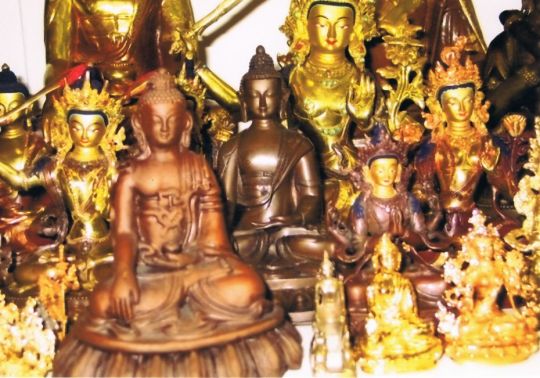
Statues ready to be filed with mantras rolled by Ven. Jan Bijman (Konchog Phuntsok) at Maitreya Instituut, Amsterdam, the Netherlands. Photo by Ven. Jan Bijman.
Each month Maitreya Instituut, an FPMT center in Amsterdam, the Netherlands, organizes a mantra rolling activity facilitated by Ven. Jan Bijman (Konchog Phuntsok). Students learn about and roll mantras that they can then use to fill their own statues and stupas. Greg Suffanti, a long-time student and Maitreya Instituut volunteer, shares the story.
In 2019 Maitreya Instituut will celebrate its fortieth anniversary, making it one of the oldest Buddhist organizations in the Netherlands. I’ve been a student and a volunteer at Maitreya Instituut’s Amsterdam center for nearly twenty years, and all through the years I’ve had the pleasure of knowing the very quiet and modest Ven. Jan Bijman.
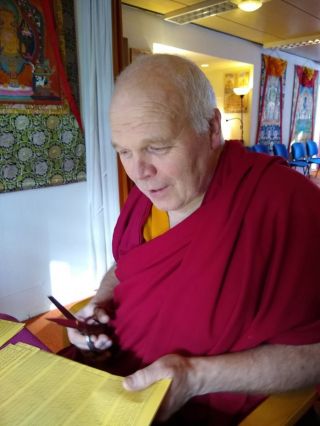
Ven. Jan Bijman (Konchog Phuntsok) holding a sheet of mantras, Maitreya Instituut, Amsterdam, the Netherlands. Photo courtesy of Maitreya Instituut.
Ven. Jan began rolling mantras back in 1983, when he went to live at the center, then located in Bruchem. Today, Maitreya Instituut has two centers: a large retreat center in Loenen and a small city center in Amsterdam.
Ven. Jan took refuge with Lama Yeshe in 1982 and took ordination on December 28, 1988.
“You have to start with a blessing,” Ven. Jan said, “which I got from Lama Zopa Rinpoche in Maasbommel, the Netherlands, sometime around 1985-1986. The blessing allows you to do the retreat and the fire puja, at which point you get permission to give the blessing of the mantra rolls.”
Ven. Jan was quick to add, “Geshe Lhundrup first helped me, as well as Geshe Sonam Gyaltsen.” Geshe Sonam Gyaltsen is Maitreya Instituut’s resident geshe.
When I asked Ven. Khedrup—who knows Ven. Jan from his years of translating for Geshe Sonam Ngodrup in Holland—to comment about Ven. Jan, Ven. Khedrup immediately replied, “Patient acceptance is what I think of when I think of Ven. Jan. He’s not the type of person who seeks the limelight for himself. An example to all. A quiet, steady presence who inspires all with his patience and acceptance.”
There are many tasks and rituals involved in the process of filling a statue—from copying the mantras on to paper, which has to be dyed saffron yellow—to carefully cutting out the individual mantras on a single sheet, then rolling each one tightly around a stick of incense, to then bundling the incense in saffron colored cloth.
When I asked Paula de Wijs, Amsterdam center director and Maitreya Instituut co-founder, to comment for this story, she said, “Mantra rolling is a quiet thing, not spectacular to watch or participate in. But it reflects what it takes to keep a Buddhist center open and on track … persistence, patience, having an idea what you are working towards, doing it all with a good motivation for the benefit of all, knowing that even seemingly small actions can culminate in producing something of great meaning.”
Paula continued, “In Dutch there is a term, monnikenwerk, which literally translates as ‘monk’s work,’ meaning doing something that takes time and patience to do, and that is exactly what mantra rolling is.”
We are fortunate at Maitreya Instituut that so many people like Ven. Jan have selflessly given their lives to help keep the two centers alive and thriving for forty years. This is quite remarkable in this day and age.
When I asked Ven. Jan where he gets the inspiration decade after decade to make mantra rolls and fill statues, he said with a big smile, “The pleasure is the people. When I give a filled statue back, the receiver is always so happy. Their happiness inspires me.”
For more information about Maitreya Instituut, visit their website:
https://maitreya.nl/index.htm
This story was originally published by the Quest for Wisdom Foundation on their website:
https://questforwisdom.org/wijsheid/bringing-buddhist-statues-to-life-with-mantras/#_ftn1
Essential Mantras for Holy Objects (statues, stupas, and tsa-tas) is available for free download from FPMT.org:
https://fpmt.org/teachers/zopa/advice/essential-mantras-for-holy-objects/
FPMT.org and Mandala Publications brings you news of Lama Zopa Rinpoche and of activities, teachings, and events from over 160 FPMT centers, projects, and services around the globe. If you like what you read, consider becoming a Friend of FPMT, which supports our work.
30
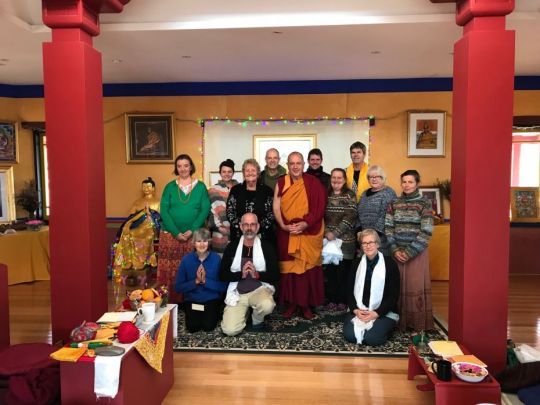
Ven. Thubten Dondrub with students Phoebe McColl, Catherine Honeychurch, Peter Koegst, Paul Kersten, Katherine Danford-Storey, Marlene Robins, Tim Eisemann, John Niessen, Judy Wagner, Sue Dixon, as well as center director Becky Geisler and center manager Fran Rowley, De-Tong Ling Retreat Centre, Kangraroo Island, South Australia, October 2018. Photo by retreatant.
Each year De-Tong Ling Retreat Centre, an FPMT center on Kangaroo Island, South Australia, offers an annual ten-day lamrim meditation retreat. Anthony Reid, one of the center’s board members, shares about the 2018 retreat.
Meditative retreat is a cornerstone of the Buddhist tradition. Retreat is the physical action of living in a quiet location; it is avoiding unnecessary conversations; and it is the process of cultivating mental focus on the Buddhadharma.
It takes special conditions for a meditative retreat to be effective, powerful, and transformative. Lama Zopa Rinpoche said, “A retreat place is not for gaining power like black magic, it’s not for a honeymoon or holiday. Also it is not a place in which to be spaced out.
“The whole purpose of a retreat place is to subdue the mind and to actualize the lamrim up to enlightenment. It is a place for a holiday from negative karma, a holiday from the three poisonous minds and the self-cherishing thought, a holiday from the self-grasping of the person and phenomena, a holiday from the wrong concepts: non-devotional thought towards the guru up to the subtle dual view of white, increasing, attainment.”
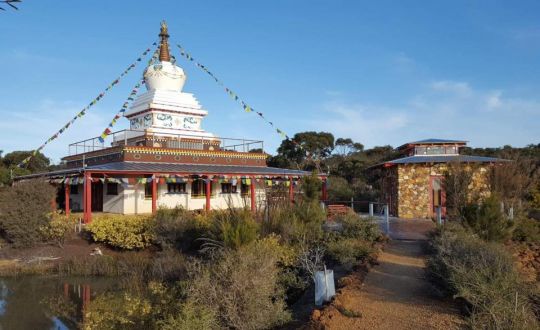
Enlightenment stupa and prayer wheel house, De-Tong Ling Retreat Centre, Kangaroo Island, South Australia, July 2018. Photo courtesy of De-Tong Ling Retreat Centre.
At De-Tong Ling Retreat Center, located on the beautiful Kangaroo Island off the southern coast of South Australia, the conditions for deep retreat are met.
Ten people joined experienced FPMT registered teacher Ven. Thubten Dondrub for the annual Ten-Day Lamrim Retreat at De-Tong Ling, from October 1-10, 2018.
Lamrim teachings and guided meditations by Ven. Thubten Dondrub were aimed at facilitating internal experience and transformation for the retreatants. With the optimal external conditions of a silent meditation hall located beneath an inspiring enlightenment stupa overlooking a turquoise blue lake and a view out across pristine native vegetation towards the distant ocean, the retreat delivered experience in abundance for the fortunate attendees.
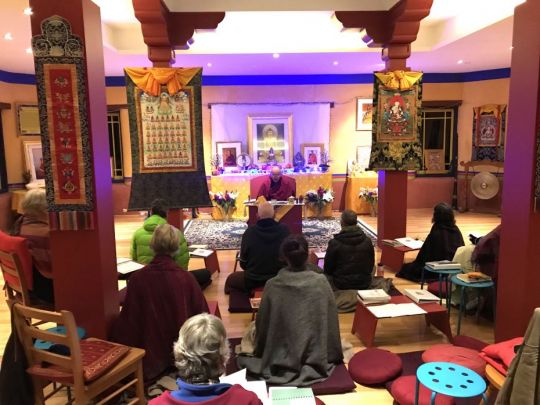
Ven. Thubten Dondrub and students inside of the gompa beneath the enlightenment stupa, De-Tong Ling Retreat Centre, Kangaroo Island, South Australia, October 2018. Photo by retreatant.
“Being led through meditations … and reflecting on the lamrim brings the teachings alive and has deepened my understanding,” shared one retreatant.
One of the benefits of group retreat is having support of fellow attendees. One attendee noted the group energy made “the atmosphere very pleasant,” and people found courage to persist through times of difficulty and clarify their perceptions of the teachings through focused discussion.
Accommodation at De-Tong Ling was enjoyed by all, with some opting for rooms in the eco-friendly rammed earth house on adjoining Yacca Creeks land, and others for more “rustic” experience in tents. Either way the opportunity to get back in touch with nature, with the vast Kangaroo Island skies and the silence of the Australian bush, brought a new level of experience for the retreatants.
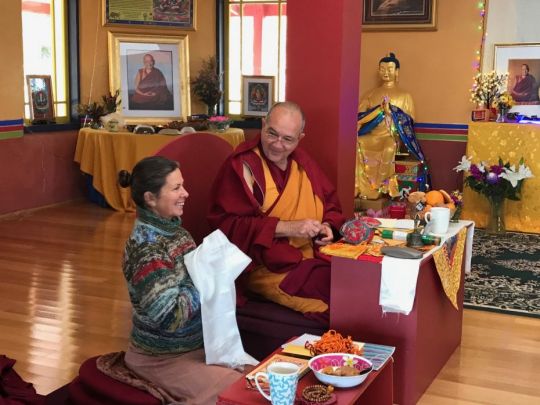
Ven. Thubten Dondrub and De-Tong Ling Retreat Centre center manager Fran Rowley, De-Tong Ling Retreat Centre, Kangaroo Island, South Australia, October 2018. Photo by retreatant.
And the conclusion? Participants were grateful for the opportunity to connect with Dharma at a deeper level. In the words of one, they “returned to mundane life with enhanced motivation to put a more concentrated and consistent effort into my practice.”
Taking the experience into daily life will be forever one of the challenges of retreat. With a clarity derived from the retreat another participant noted, “Dharma is about perfection but until then it’s about progress.”
We hope that this transition to daily life outside of the retreat setting will be made easier knowing a place like De-Tong Ling is in existence and is a sanctuary for students from across FPMT providing the perfect conditions for retreat.
For more information about De-Tong Ling Retreat Centre, visit their website:
https://detongling.org/
This story was originally published on De-Tong Ling Retreat Centre’s website:
https://detongling.org/events/
FPMT.org and Mandala Publications brings you news of Lama Zopa Rinpoche and of activities, teachings, and events from over 160 FPMT centers, projects, and services around the globe. If you like what you read, consider becoming a Friend of FPMT, which supports our work.
- Tagged: anthony reid, de-tong ling, lamrim, retreat, ven. thubten dondrub
23
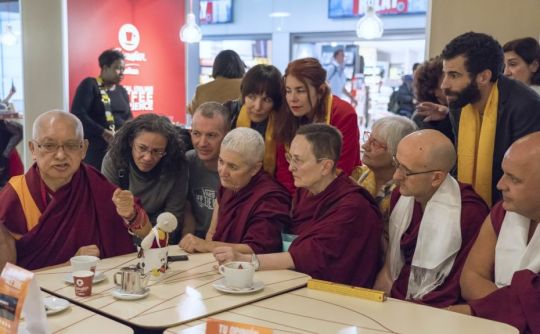
Lama Zopa Rinpoche giving last-minute advice to students Karen, Steve, Susana, Alejandra, Ven. Paloma, Ven. Begoña, Rosario, Daniel, Ven. Jesus, and Ven. Tendar gathered around him at a cafe at the Madrid-Barajas Airport, Madrid, Spain, November 2018. Photo by Ven. Lobsang Sherab.
Lama Zopa Rinpoche visited Madrid, Spain, from October 16 to November 3, 2018. The visit was organized by FPMT Hispana. The FPMT Hispana community shares the story.
FPMT Hispana will host Rinpoche in Madrid again from April 26-29, 2019. Rinpoche is scheduled to give the White Umbrella (Dukkar) great initiation.
It was May 2018 that we got the news that Lama Zopa Rinpoche could come to Spain in October. We didn’t hesitate for a moment, and said, “Yes, we can organize it.” We had four months to prepare for a visit that we had been waiting for in Spain for many many years.
We worked tirelessly, sometimes day and night. We managed to have everything ready the day Rinpoche arrived in Madrid.
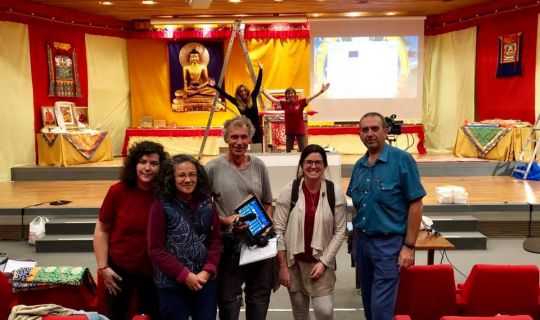
Volunteers Melanie and Lou on the stage, and Isabel, Karen, Toine, and Irina with a wonderful venue employee preparing Auditorio UGT for Lama Zopa Rinpoche’s teachings, Madrid, Spain, October 2018. Photo by Centro Nagarjuna Valencia.
On October 16 many people were waiting in the Madrid airport for Rinpoche’s arrival. There was so much joy and happiness in the air, and people brought many flowers. Some traveled four or five hours by car or bus to see Rinpoche before returning the same night and going to work the next day.
It felt like a dream having Rinpoche in Madrid. He took care of everyone in such a kind way, as a mother takes care of her child. When you are around Rinpoche you can feel this endless flow of love and wisdom, and you know you are in the best hands.
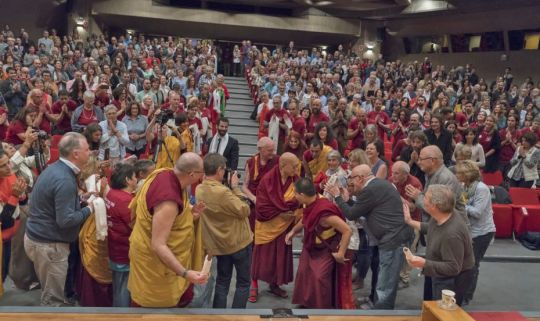
Lama Zopa Rinpoche greeted by students in Auditorio UGT, Madrid, Spain, October 2018. Photo by Ven. Lobsang Sherab.
He taught October 19-21 and the following weekend, October 26-28, in a conference hall in Madrid with more than 600 people each weekend coming from every corner of Spain, other places in Europe, and even a few from the United States and Mexico.
Rinpoche gave us amazing teachings during these two weekends. As the planned White Umbrella initiation didn’t happen, he gave us the opportunity to create merit organizing everything, and we had the opportunity to request it again.
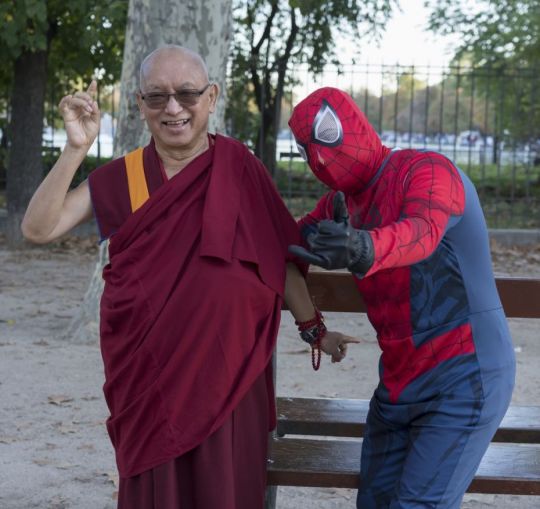
Lama Zopa Rinpoche with a person dressed in a Spider-Man costume in Retiro Park, Madrid, Spain, October 2018. Photo by Ven. Lobsang Sherab.
Rinpoche spend some time with Tenzin Ösel Hita and his son, Norbu, and was also visited by FPMT resident geshe Geshe Lamsang, the resident teacher at FPMT center Centro Nagarjuna Valencia.
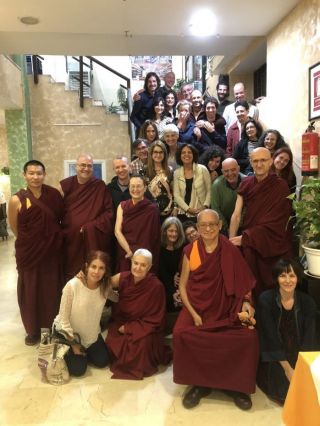
Lama Zopa Rinpoche with FPMT Spain center staff members after having dinner together, Madrid, Spain, October 2018. Photo by Ven. Roger Kunsang.
Rinpoche also had time to visit some places around Madrid. He got to walk around Retiro Park where he made new friends, connecting so easily with everyone as always, and bringing smiles to people’s faces.
Rinpoche also made time to have dinner with FPMT Hispana center directors, spiritual program coordinators, and registered teachers, giving advice to each about their centers and the organization.
On the last day in the airport, Rinpoche was incredibly generous, spending time with all the people that had gone to the airport to see him. He gave some spontaneous teachings to all the students sitting around him in a cafe in the airport.
Those three weeks felt like a dream in many many ways, and we will keep working for it to be repeated soon.
Enjoy more photos from Lama Zopa Rinpoche’s visit to Madrid, Spain:
https://fpmt.org/teachers/zopa/gallery/spain-october-2018/
For more information about FPMT Spain, visit their website:
http://fpmt-hispana.org/
Watch video recordings of Lama Zopa Rinpoche’s teachings from his 2018 European tour, which includes Spain, Germany, and Switzerland, and also find audio recordings of translations of the teachings in several languages as well as English language transcripts here:
https://fpmt.org/media/streaming/teachings-of-lama-zopa-rinpoche/europe-tour-2018/
For information about Lama Zopa Rinpoche’s 2019 activities, visit Rinpoche’s schedule:
https://fpmt.org/teachers/zopa/schedule/
FPMT.org and Mandala Publications brings you news of Lama Zopa Rinpoche and of activities, teachings, and events from over 160 FPMT centers, projects, and services around the globe. If you like what you read, consider becoming a Friend of FPMT, which supports our work.
16
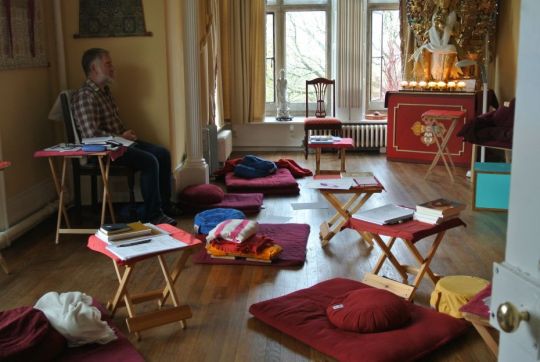
Retreatant Karl engaged in meditation during the lamrim retreat, Land of Joy, Northumberland, UK, November 2018. Photo by retreatant.
Land of Joy, an FPMT center in Northumberland National Park, UK, hosted their annual ten-day lamrim retreat November 2-11, 2018, led by FPMT registered teacher Ven. Mary Reavey. Retreatant Sheri Lim and fellow retreatants share about the experience.
Everyone had a fulfilling ten days at the lamrim retreat led by Ven. Mary Reavey at Land of Joy in November. The ten retreatants were from all walks of life, different countries, ages, and stages in their lives and in their understanding of the Dharma, but the environment at Land of Joy and the wonderful teaching by Ven. Mary created a warm and friendly space for everyone to grow and share together. Excellent food and care by Land of Joy volunteers made for an amazing stay—certainly no lack of biscuits and cheese!
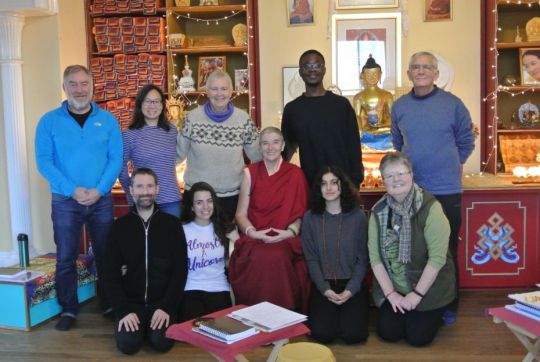
Standing students Karl, Sheri, Carolyn, Kobe, and David, and seated students Matthew, Aline, Sadaf, and Pauline with FPMT registered teacher Ven. Mary Reavey, Land of Joy, Northumberland, UK, November 2018. Photo by retreatant. Not pictured: Matthew
Group retreats are a great way to take time out from our worldly lives and look inward, but in the company of others who also want to learn. As a result of being led by an incredible teacher whose depth of knowledge is inspiring and motivating, each person can get what is useful for them individually and carry it with them into their lives. Whether it’s varying our meditation practice, better understanding karma or emptiness, or feeling better about dying, this retreat allowed us to explore the Dharma more deeply.
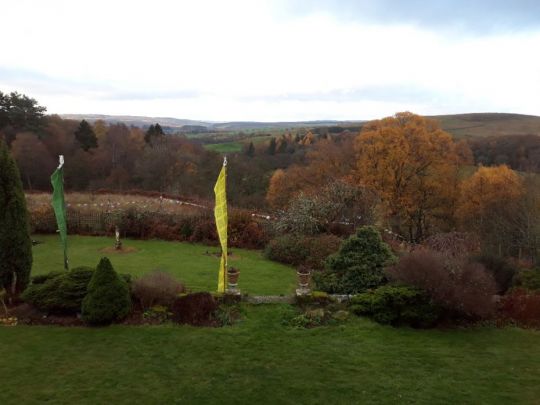
Land of Joy, Northumberland, UK, November 2018. Photo by retreatant.
As we all said our goodbyes at the end of the retreat, it was clear that it has left us with a stronger commitment to expand our learning and practicing of the Dharma. We hope to see each other again at FPMT centers and future retreats!
For more information about Land of Joy, visit their website:
http://landofjoy.co.uk/
FPMT.org and Mandala Publications brings you news of Lama Zopa Rinpoche and of activities, teachings, and events from over 160 FPMT centers, projects, and services around the globe. If you like what you read, consider becoming a Friend of FPMT, which supports our work.
- Tagged: lamrim, land of joy, ven. mary reavey
9
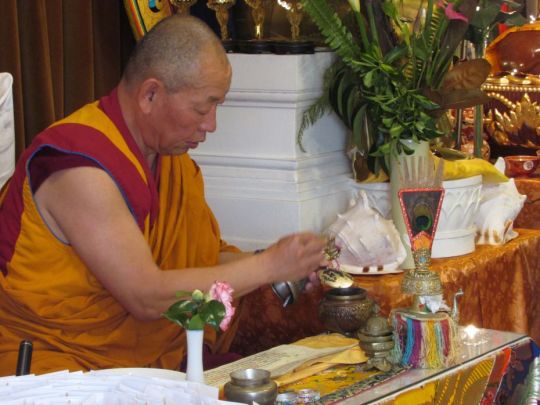
Geshe Thupten Wangchen burning a scorpion made out of black sesame seeds at the Jangwa Puja, Dorje Chang Institute, Auckland, New Zealand, August 2018. Photo by Mark Heron.
Each year Dorje Chang Institute, an FPMT center in Auckland, New Zealand, organizes a Yamantaka Jangwa Puja. Venerable Gyälten Wangmo, spiritual program coordinator, shares about the most recent puja which took place on August 25, 2018.
Our FPMT resident teacher Lharampa Geshe Thupten Wangchen kindly performs a Yamantaka Jangwa Puja every August.
The first part of the Jangwa Puja is for the living. Geshe-la encourages people to attend in person if possible. This includes rituals to help purify obstacles, illness, disease, and more.
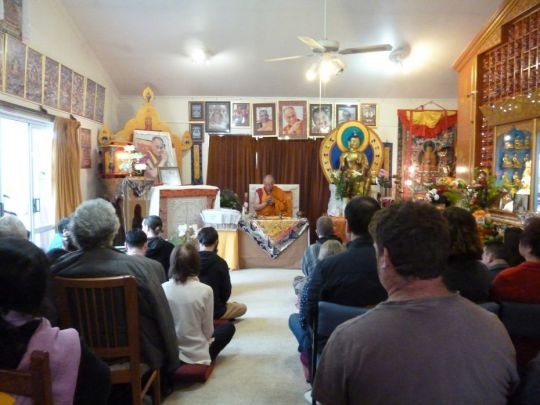
Jangwa Puja at Dorje Chang Institute, Auckland, New Zealand, August 2018. Photo by Ven. Gyälten Wangmo.
It is very participatory. At one part people absorb impurities, illnesses, and pains into handfuls of dough. At another point people rinse their mouths and impurities with the ritual vase water, which is then spit out into a bowl containing everyone’s handfuls of dough.
People also have the opportunity to come up to Geshe-la’s table and exhale all of their negativities onto a scorpion made of black sesame seeds. This scorpion is then symbolically burnt up, and then at one point people stand up to do prostrations to the Buddhas.
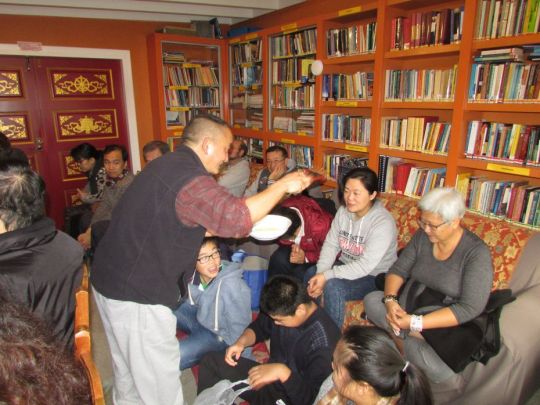
Jangwa Puja guests receiving Buddha bath water blessings at Dorje Chang Institute, Auckland, New Zealand, August 2018. Photo by Mark Heron.
The next section of the Jangwa Puja is for those who have passed away at any time in the past. In advance of the puja people register the names of those who have passed away, including relatives, friends, workmates, or anyone they wish to include in the puja. They also have the option of submitting a photo of those who have died.
A small placard is created for each one that includes a traditional drawing on the front with the name on the lotus and photo of the deceased above. On the back is the prayer:
“Bhagavan Manjushri-Yamantaka’s hosts of deities, grant your blessings so that this person who has passed away purifies all of their negativities, obscurations and imprints accumulated in many lifetimes without beginning, and attains complete, perfect enlightenment swiftly.”
Each small placard is placed on a skewer, and then all of the skewers are stuck into a large lotus.
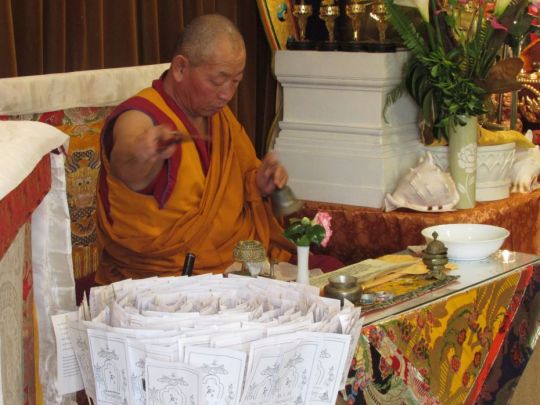
Geshe Thupten Wangchen at the Jangwa Puja, Dorje Chang Institute, Auckland, New Zealand, August 2018. Photo by Mark Heron.
During the second part of the Annual Jangwa Puja, Geshe-la then performs a series of rituals similar to the above to help those beings purify negativities, have good rebirths—especially in a pure land—and to meet with all conducive factors for happiness.
Audience members then have the opportunity to stand up and do prostrations on behalf of their loved ones.
At the very end, all of the placards are offered into a small fire. While this is happening Geshe-la does prayers and rituals, and the audience members make strong prayers that they all be reborn in a pure land or at least receive a perfect human rebirth with all advantages for creating the causes for happiness and enlightenment.
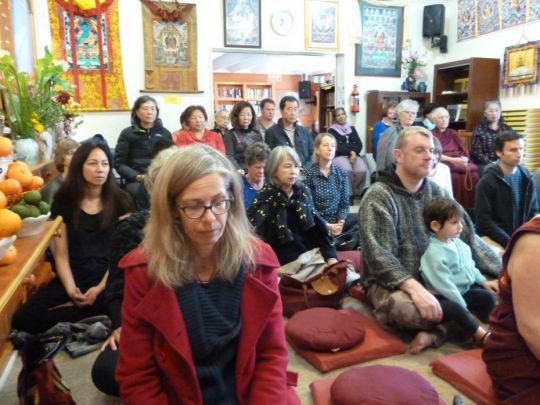
Guests attending the Jangwa Puja at Dorje Chang Institute, Auckland, New Zealand, August 2018. Photo by Rinchen Dhondup.
Participation in this annual puja is gaining momentum. It seems that people really appreciate having something they can do that not only benefits themselves but is something helpful and positive they can do for those with whom they have a connection. It offers a formal opportunity to do something meaningful for loved ones who have passed away even a while ago.
I feel this is rare in the West. Sometimes it is palpable how much people appreciate the chance to helped deceased loved ones.
For more information about Dorje Chang Institute, visit their website.
http://www.dci.org.nz/
You can find advice on practice for death and dying here:
https://fpmt.org/death/
FPMT.org and Mandala Publications brings you news of Lama Zopa Rinpoche and of activities, teachings, and events from over 160 FPMT centers, projects, and services around the globe. If you like what you read, consider becoming a Friend of FPMT, which supports our work.
- Tagged: death and dying, dorje chang institute, geshe thupten wangchen, jangwa puja, ven. gyalten wangmo
2
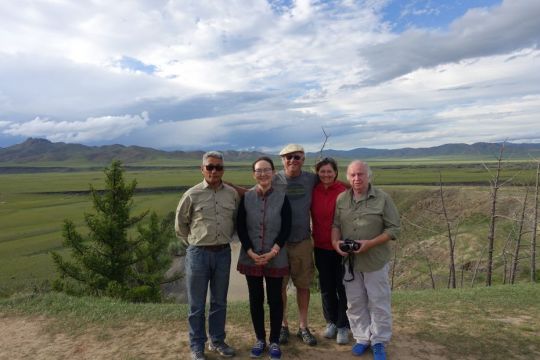
Driver Oyunbaatar, Ganden Do Ngag Shedrup Ling center director Ianzhina, Bill, Elena, and Cees on pilgrimage in Mongolia, August 2018. Photo courtesy of Ianzhina Bartanova.
Ianzhina Bartanova, director of FPMT center Ganden Do Ngag Shedrup Ling in Ulaanbaatar, Mongolia, shares about an August 2018 fourteen-day pilgrimage the center organized to holy sites in Mongolia. This is a short excerpt from Ianzhina’s published online story, The Karmic Bond That Connected Us All in Mongolia.
Ganden Do Ngag Shedrup Ling placed an advertisement in the January-June 2018 issue of FPMT’s Mandala magazine inviting readers to join us for an August 2018 pilgrimage to the holy sites in Mongolia. It was the first pilgrimage for Western Buddhists organized by Ganden Do Ngag Shedrup Ling. Three courageous students from Bulgaria, Holland, and the US arrived in Mongolia in mid-August for the eleven-day pilgrimage, which later expanded into fourteen days.
The capital of Mongolia, Ulaanbaatar, is impressive: tall modern buildings, busy traffic, expensive cars on the roads, fancy restaurants with international cuisine including vegan and vegetarian options, comfortable hotels, and smiling people.
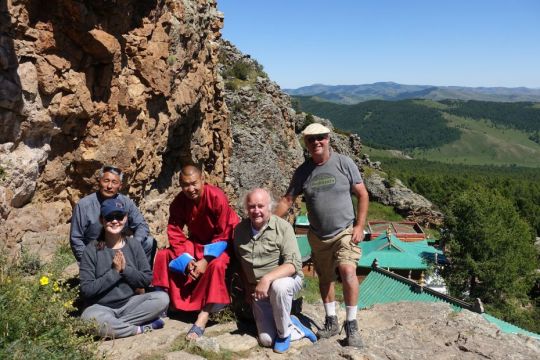
Driver Oyunbaatar, Ganden Do Ngag Shedrup Ling center director Ianzhina, lama from Tuvkhun Monastery, Cees, and Bill in Mongolia, August 2018. Photo courtesy of Ianzhina Bartanova.
But the real jewels of our pilgrimage were the Mongolian monasteries, some of which were destroyed and then restored. A few survived the Communist purges of the 1930s, and are home to some hidden artifacts which were buried in the ground. Like the canvas for a masterpiece, Mongolia’s natural environment provided a framed backdrop for the holy sites, which appear like beautiful jewelry.
Together with the pilgrims, we visited approximately ten monasteries, took in a few natural sights, and made some visits related to Buddhist museums. When developing the itinerary, we recognized the importance of sharing some cultural aspects and traditions so our guests could have a richer experience of Mongolia. Therefore, we included some secular activities such as a traditional music show and a sightseeing visit to the largest Genghis Khan equestrian statue. …
Read Ianzhina’s full online story, “The Karmic Bond That Connected Us All in Mongolia,” and view more of her photos online:
https://fpmt.org/mandala/in-depth-stories/the-karmic-bond-that-connected-us-all-in-mongolia/
For more information about Ganden Do Ngag Shedrup Ling, visit their website:
http://www.fpmtmongolia.org/shedrub-ling-center
FPMT.org and Mandala Publications brings you news of Lama Zopa Rinpoche and of activities, teachings, and events from over 160 FPMT centers, projects, and services around the globe. If you like what you read, consider becoming a Friend of FPMT, which supports our work.
- Home
- News/Media
- Study & Practice
- About FPMT Education Services
- Latest News
- Programs
- New to Buddhism?
- Buddhist Mind Science: Activating Your Potential
- Heart Advice for Death and Dying
- Discovering Buddhism
- Living in the Path
- Exploring Buddhism
- FPMT Basic Program
- FPMT Masters Program
- FPMT In-Depth Meditation Training
- Maitripa College
- Lotsawa Rinchen Zangpo Translator Program
- Universal Education for Compassion & Wisdom
- Online Learning Center
- Prayers & Practice Materials
- Overview of Prayers & Practices
- Full Catalogue of Prayers & Practice Materials
- Explore Popular Topics
- Benefiting Animals
- Chenrezig Resources
- Death & Dying Resources
- Lama Chopa (Guru Puja)
- Lama Zopa Rinpoche: Compendium of Precious Instructions
- Lama Zopa Rinpoche: Life Practice Advice
- Lama Zopa Rinpoche Practice Series
- Lamrim Resources
- Mantras
- Prayer Book Updates
- Purification Practices
- Sutras
- Thought Transformation (Lojong)
- Audio Materials
- Dharma Dates – Tibetan Calendar
- Translation Services
- Publishing Services
- Teachings and Advice
- Find Teachings and Advice
- Lama Zopa Rinpoche Advice Page
- Lama Zopa Rinpoche: Compendium of Precious Instructions
- Lama Zopa Rinpoche Video Teachings
- ༧སྐྱབས་རྗེ་བཟོད་པ་རིན་པོ་ཆེ་མཆོག་ནས་སྩལ་བའི་བཀའ་སློབ་བརྙན་འཕྲིན།
- Podcasts
- Lama Yeshe Wisdom Archive
- Buddhism FAQ
- Dharma for Young People
- Resources on Holy Objects
- Ways to Offer Support
- Centers
- Affiliates Area
- Teachers
- Projects
- Charitable Projects
- Make a Donation
- Applying for Grants
- News about Projects
- Other Projects within FPMT
- Support International Office
- Projects Photo Galleries
- Give Where Most Needed
- FPMT
- Shop
Subscribe to FPMT News
Translate*
*powered by Google TranslateTranslation of pages on fpmt.org is performed by Google Translate, a third party service which FPMT has no control over. The service provides automated computer translations that are only an approximation of the websites' original content. The translations should not be considered exact and only used as a rough guide.One must practice with the bodhisattva attitude every day. People can’t see your mind, what people see is a manifestation of your attitude in your actions of body and speech. Pay attention to your attitude all the time, guard it as if you are the police, or like a maid cares for a child, like a bodyguard, or like you are the guru and your mind is your disciple.






